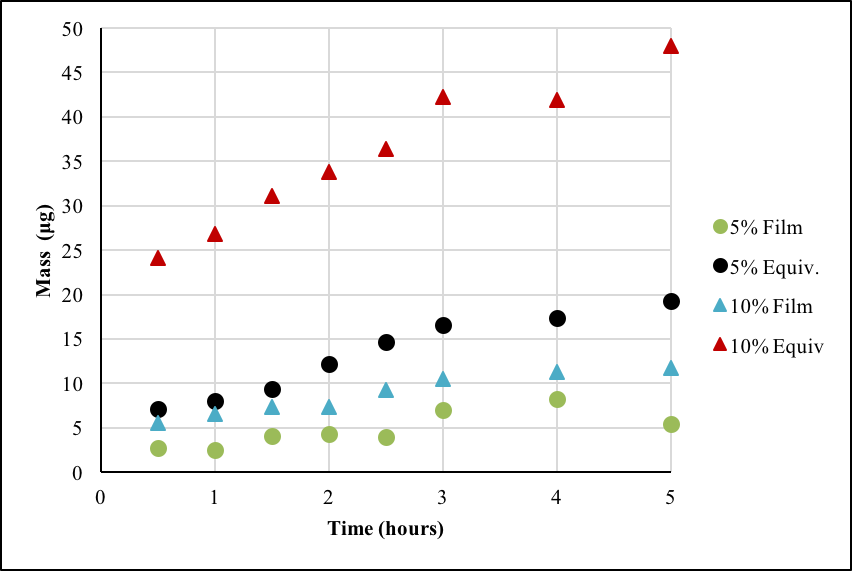By: Sean M. Bittner, Lee Robeson, Edward W. Davis
Effective wound treatment is a prominent issue in medicine. Identifying and treating persistent infections is particularly important, as untreated infections can rapidly escalate. Halloysite, a naturally abundant, nontoxic clay nanotube, can be loaded with 10-30 wt % antibiotic, extending release from minutes to hours or days, and has been shown to improve the drug encapsulation of polymer films when admixed. However, the literature surrounding halloysite is deficient in some areas. Although poly (vinyl alcohol) (PVOH) and poly (methyl methacrylate) (PMMA) composites are common, experiments with other biologically relevant polymers are limited. Additionally, the literature primarily consists of experiments using tetracycline, a small, water-soluble antibiotic. My project attempts to address these deficits by (a) investigating drug release from poly (lactic-co-glycolic acid) (PLGA) composite films, a polymer widely used in the medical community, and (b) investigating the release of novel antibiotic gentamicin sulfate and comparing to that of tetracycline.
To evaluate tetracycline release from composite films, drug-loaded halloysite/PLGA film slices were added to deionized water and held at 37°C in a shaking water bath. Samples were periodically tested using a UV spectrophotometer. Controls were prepared with pure PLGA, unloaded halloysite/PLGA composites, and tetracycline-loaded PLGA.
On release, the “burst” of drug content is significantly reduced and release is prolonged. On comparison of the 5% drug-loaded halloysite (DLH)/PLGA composite and equivalent polymer, an approximate 30% decrease in release rate is observed, indicating considerably better encapsulation. A similar relationship is observed between the 10% DLH/PLGA film and equivalent, yielding ~75% reduction. Drug encapsulation was also demonstrated by comparing the 5% drug-loaded polymer with the 10% DLH/PLGA film. Despite the composite having twice as much loaded drug, the drug released after five hours was much higher in the 5% pure polymer, again indicating that halloysite incorporation is effective at mitigating antibiotic release.
The tetracycline results matched expectations from previous work and the literature at large. A block ratio comparison study also shed light on how this ratio impacts drug release; it was noted that increasing lactic acid yielded a higher initial burst and overall release rate, indicating some insolubility of tetracycline in lactic acid. However, it was noted that halloysite incorporation into an 85:15 (LA:GL) composite film tailored release between a pure 50:50 film and a 50:50 composite film, which is beneficial in the case that a lactic acid-based polymer is needed for drug delivery.
The results of novel antibiotic trials were inconclusive, owing to unforeseen complications caused by heating composite films. Release profiles suggested significant drug degradation, as the total mass in solution over time appeared to decrease. Ultraviolet (UV) analysis of gentamicin solutions, however, showed that the drug produced consistent absorbance spectra. Components of the o-phthaldialdehyde solution, which is used as a drug marker in UV testing, were similarly tested and were determined to be chemically stable. As a result of these tests, combined with the negligible impact of heat treatment on halloysite below 100°CI, it is suspected that the PLGA itself masks the absorbance signature of gentamicin.
Moving forward, several areas should be investigated. The immediate focus should be alternative quantification for gentamicin. Several alternatives are being explored, with High Performance Liquid Chromatography being the most popular. It is also important to measure degradation rates of the composites as a result of halloysite incorporation, as the degradation profile of the chosen material needs to fit the application.
Statement of Research Advisor
The research Sean has conducted demonstrates the ability to utilize halloysite as a drug reservoir in biodegradable polymer systems. His efforts have demonstrated controlled release from these composite materials. His work forms the foundation for understanding of the combined effects of polymer degradation and desorption from the halloysite lumen on release of bioactive molecules from these materials
—Edward Davis, Materials Engineering

Figure 1. Tetracycline release from DLH/50:50 PLGA using 5 and 10 wt% composite films and equivalent hallyosite-free films.
Last Modified: